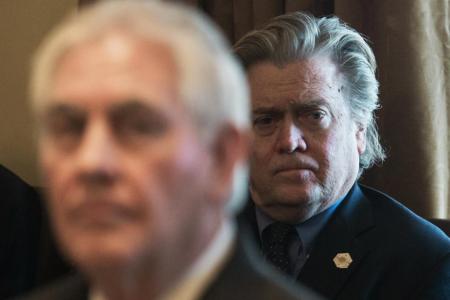Donald Trump thanks ousted aide Steve Bannon
Donald Trump on Saturday (Aug 19) thanked Steve Bannon for his “service” a day after the US president parted ways with his controversial former chief strategist and key campaign ally.
A champion of the nationalist-populist agenda that carried Trump to power last November, the 63-year-old Bannon left a White House reeling from the fallout over the president’s response to a violent white supremacist rally.
“I want to thank Steve Bannon for his service. He came to the campaign during my run against Crooked Hillary Clinton – it was great! Thanks,” Trump tweeted Saturday.
Bannon, a hero of the so-called “alt right” whose presence in the West Wing was controversial from the start, had become the nucleus of one of several competing power centres in a chaotic White House.
With Trump under fire for insisting anti-racism protesters were equally to blame for violence at a weekend rally of neo-Nazis and white supremacists in Charlottesville, Virginia, the president faced renewed pressure to let Bannon go.
The departure, capping one of the most disastrous weeks of the chaotic young administration, is a nod to members of Trump’s government and his Republican Party grown increasingly frustrated with the anti-establishment firebrand.
It remains to be seen what role the serial provocateur will continue to play from outside the White House, but Bannon himself vowed to keep pushing Trump’s right-wing agenda, as he returned to his former home at the ultra-conservative website Breitbart News.
“If there’s any confusion out there, let me clear it up: I’m leaving the White House and going to war for Trump against his opponents – on Capitol Hill, in the media, and in corporate America,” Bannon said in an interview within hours of leaving the White House.
Bannon, Trump's Great Manipulator
When Steve Bannon gave a free-wheeling interview to a small left-wing magazine this week, he spoke as if he – the White House’s ‘great manipulator’ – was back on top.
By Friday, President Donald Trump had sacked him.
However, in a matter of hours Bannon vowed to go to war for the president and keep fighting what he called his enemies in Congress and elsewhere.
Some reports suggest that Trump’s strategy chief already knew his days were numbered when he picked up the phone to make a surprise call to the American Prospect.
But he gave no hint of it as he regaled editor Robert Kuttner with plans to push aside his rivals within Trump’s administration and start a trade war with China.“To me, the economic war with China is everything. And we have to be maniacally focused on that,” he declared.
This week, however, the national security establishment was focused on North Korea’s nuclear threat – a crisis dismissed as a “sideshow” by Bannon.
And much of the media and the US public was focused on a threat much closer to home: white nationalism and the rise of the so-called “alt-right.”
In his interview, Bannon was dismissive of the torch-bearing “clowns” in polo shirts and khakis who brought violence to Charlottesville last week.
But – for all he would like to be seen as the mastermind behind Trump’s improbable rise to power – Bannon’s image is still linked to those white nationalists.
Before joining Trump’s campaign, Bannon the self-described “economic nationalist” was the publisher of Breitbart, the provocative right-wing news outlet which he rejoined within hours of leaving the White House.
This site was and is, in Bannon’s own words, a platform for the alt-right, a loosely defined movement of mainly young white men espousing far-right and white nationalist ideas.
Any temptation to laugh off the alt-right as online poseurs evaporated on Saturday when a white supremacist rally in Charlottesville degenerated into violence.
A suspected Nazi sympathizer then drove his car into a crowd of anti-racism demonstrators, leaving one woman dead.
When Trump himself drew fire for defending some of the right-wing crowd as “fine people,” eyes also turned to Bannon, as the figurehead of the “nationalist” camp within the White House.
In his first comments since his departure was announced, Bannon vowed to keep fighting for the president from outside the White House.
“If there’s any confusion out there, let me clear it up: I’m leaving the White House and going to war for Trump against his opponents – on Capitol Hill, in the media, and in corporate America,” the far-right firebrand said in an interview with Bloomberg News.
And Breitbart News said he was coming back as executive chairman.
Global power
In an op-ed on the site, Breitbart writer Joel Pollak suggested that Trump ousted Bannon in “an effort to save his presidency after Charlottesville” but warned the president not to turn his back on his right-wing supporters.“Steve Bannon personified the Trump agenda,” Pollak wrote.
The 63-year-old former navy lieutenant turned political operative was seen as the brain behind Team Trump’s decision to rail against a “global power structure” opposed to American values – a favorite theme of nationalist conspiracy-mongers.
After making his name at Goldman Sachs during the 1980s boom years, Bannon founded his own investment bank before selling it to Societe Generale in 1998 and going on to be a Hollywood producer.
Some of his projects were standard entertainment fare, but political documentaries that he produced on late president Ronald Reagan, populist darling Sarah Palin and the Tea Party movement brought him into right-wing circles.
Ultimate outsider
Bannon became an investor in Andrew Breitbart’s eponymous media venture – focused around a site designed to buck what its founder saw as the progressive left’s grip on the news agenda.
Democrats and liberals were in the site’s crosshairs, but mainstream Republican lawmakers also felt its lash, accused of failing to stand up strongly enough to then president Barack Obama
When Breitbart died in 2012, Bannon took over.
The site, which had been the ultimate outsider force, latched on to the Trump phenomenon and helped drive the billionaire to the White House.
Victory also brought Bannon to the West Wing and, for a while the ultimate anti-establishment outsider became one of the most powerful insiders on the planet, just a few steps away from Trump’s Oval Office.
He quickly raised hackles in Washington, especially at the State Department and the Pentagon, where officials resisted Bannon’s determination to exile his supposedly “globalist” foes and replace them with nationalists.
But his power rested on his relationship with Trump, who came to resent the way Bannon was portrayed as the all-powerful eminence grise behind the scenes at the White House.
Now he is an outsider again, but one who swears he’s not finished fighting for Trump.
- AFP
Get The New Paper on your phone with the free TNP app. Download from the Apple App Store or Google Play Store now


